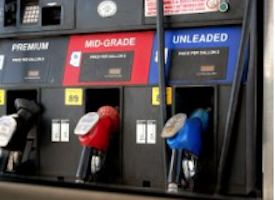The average price of gas may soon be lower than it was this time last year. That’s welcome news for holiday road trippers who faced record-breaking high prices at the pump through much of the summer travel season.
The national average has dropped 26 cents in the past two weeks. That sharp decline will likely slow in coming weeks, given the decision by OPEC+ to continue cutting production. But the good news for shoppers and travelers alike is that the general downward trend is expected to continue.
OPEC+, representing a group of 23 oil-producing nations including Saudi Arabia and Russia, decided Sunday to maintain output cuts of 2 million barrels per day or about 2% of world demand. The purpose of the move is to boost the global price of oil, which has fallen recently amid fears of demand weakness, particularly in China where restrictive lockdown measures continue, nearly three years since the start of the COVID-19 pandemic
Despite these events on the world stage, the continuation of lower prices at the pump are likely to bring joy to motorists this holiday season. The national average pump price for a gallon of gas dropped 14 cents in the past week to $3.40.
“Gas prices are dropping sharply and are only a nickel more per gallon than a year ago nationally,” says Lori Weaver Hawkins, public affairs manager, AAA Blue Grass. “In Kentucky, we’re still about 8 cents above last year, though some areas are seeing prices narrow that gap even further. As of today, Lexington is only 4 cents higher than a year ago.”
Weaver Hawkins adds that the national average may soon be lower than it was a year ago, a story that is likely to unfold locally as well.
According to data from the Energy Information Administration (EIA), gas demand held steady at 3.2 million barrels a day. Meanwhile, total domestic gasoline stocks rose by nearly 2.8 million barrels to 213.8 million barrels. Increasing supply and steady gasoline demand have contributed to pushing pump prices lower.
Monday’s national average of $3.40 is 14 cents lower than a week ago, 39 cents lower than a month ago and is just 5 cents higher than one year ago.
Kentucky’s average for a gallon of regular is now $3.11, down a penny overnight, 13 cents lower on the week and 39 cents lower compared to a month ago. A year ago, the average in Kentucky was $3.03.
Lexington’s average is now at $3.05, down 2 cents overnight, 13 cents lower than a week ago and 33 cents lower than a month ago. A year ago, the Lexington average was $3.01.
In Northern Kentucky, Covington is at $3.46, down 2 cents overnight, 13 cents lower on the week and 44 cents lower on the month. A year ago, Covington was at $3.03.
In Eastern Kentucky, motorists in Morehead are seeing the gas price average $3.37, which is stable overnight but 9 cents lower on the week and 14 cents lower than a month ago. A year ago, the average price in Morehead was $3.15.
Pikeville is at $3.05 today, no change overnight, 15 cents lower on the week and 31 cents lower on the month. A year ago, the average in Pikeville was $2.94. Ashland is at $3.25 today, up a penny overnight, but 6 cents lower on the week and 15 cents lower on the month. A year ago, the price in Ashland was $3.13.
Around the commonwealth, the highest county-level average gas price today is in Campbell County at $3.65, followed by Knott, Kenton and Pendleton, all at $3.59. The cheapest spot for gas in the commonwealth today can be found in Henderson County at $2.70.
Checking nearby, the average price for a gallon of regular today (and change compared to last week) in Ohio is at $3.25 (-0.18), West Virginia $3.39 (-0.10), Virginia $3.26 (-0.09), Tennessee $2.98 (-0.12), Indiana $3.42 (-0.22), Illinois $3.64 (-0.19) and Missouri $2.95 (-0.15).
Across the nation, the high spot remains in California at $4.77 after a 27-cent drop on the week. The lowest state-level price average can be found in Texas at $2.78.
The nation’s top 10 largest weekly decreases: California (−27 cents), Oregon (−26 cents), Nevada (−22 cents), Indiana (−22 cents), Alaska (−21 cents), Washington (−21 cents), Michigan (−19 cents), Arizona (−19 cents), Illinois (−19 cents) and Montana (−19 cents).
The nation’s top 10 least expensive markets: Texas ($2.78), Oklahoma ($2.86), Arkansas ($2.92), Mississippi ($2.94), Missouri ($2.95), Georgia ($2.95), Louisiana ($2.96), Tennessee ($2.98), Kansas ($2.99) and Wisconsin ($3.01).
At the close of Friday’s formal trading session, West Texas Intermeidate decreased by $1.24 to settle at $79.98. A weaker dollar contributed to decreasing prices. Earlier in the week, crude prices were boosted by the EIA reporting that total domestic commercial crude stocks fell dramatically by 12.6 million bbl. The domestic commercial crude supply is 14 million bbl lower than at the end of November 2021. For this week, crude prices could rise in response to the European Union, Australia, Japan, United States, Canada, and the U.K. beginning to implement a $60 per barrel price cap on Russian seaborne crude oil, which is meant to limit the country’s revenues in response to the Ukrainian invasion. This effort follows Sunday’s virtual meeting for the Organization of the Petroleum Exporting Countries (OPEC) and its allies, also known as OPEC+, where the cartel agreed to keep its production reduction agreement of 2 million b/d unchanged through 2023.
From AAA Blue Grass























